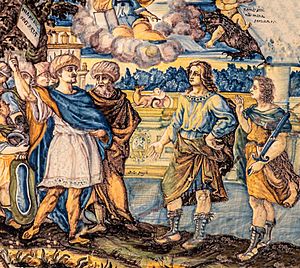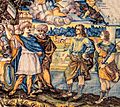Lysander facts for kids
Quick facts for kids
Lysander
|
|
|---|---|

Lysander outside the walls of Athens, ordering their destruction. 19th century lithograph
|
|
| Born | c. 454 BC |
| Died | 395 BC |
| Allegiance | Sparta |
| Rank | Navarch |
| Battles/wars | Peloponnesian War
|
Lysander (died 395 BC) was a powerful military and political leader from Sparta. He is famous for destroying the Athenian navy in 405 BC at the Battle of Aegospotami. This victory forced Athens to surrender, ending the long and difficult Peloponnesian War.
After the war, Lysander played a major role in Sparta's control over Greece for about ten years. He wanted Sparta to be the main power, replacing the Athenian Empire.
Contents
Early Life of Lysander
Not much is known about Lysander's early life. He was likely born around 454 BC. His father, Aristocritus, was from a family that claimed to be related to the hero Heracles. However, they were not part of Sparta's royal families.
Ancient writers say that Lysander grew up without much money. He was known for being obedient and having a strong, brave spirit. He became an admiral in Sparta's navy in 408 BC. This was during the ongoing Peloponnesian War against Athens.
Lysander as Admiral
Lysander began gathering ships from different Greek cities. His main naval base was in Ephesus. Soon after he arrived, Cyrus, the young son of the Persian king, came to the area. Cyrus was in charge of some Persian provinces in Asia Minor.
Lysander quickly met with Cyrus and made a strong impression on him. They became close friends. Cyrus started giving a lot of money to Sparta to help with the war. He even helped Lysander pay his sailors more. This made the Spartan crews happier and more loyal to Lysander.
Lysander also met with important leaders from Greek cities in the Aegean Sea. He encouraged them to form political groups. He promised to help them gain power if Athens was defeated. This created a network of allies who were loyal to Lysander. They eagerly helped Sparta's war efforts.
While Lysander was preparing his ships, an Athenian fleet arrived nearby. It was led by the famous Alcibiades. Lysander avoided a direct battle at first. He hoped his higher-paid crews would encourage Athenian sailors to leave their ships.
Eventually, a small fight broke out between some ships. Lysander quickly ordered his whole fleet to attack. He pushed back the Athenian ships, causing some damage. Alcibiades returned and tried to challenge Lysander to another battle, but Lysander refused. The Athenians had to leave.
After this victory, Lysander's time as admiral ended. Spartan law did not allow an admiral to hold office twice in a row. So, Callicratidas replaced him. Lysander returned all the money Cyrus had given him, making it harder for Callicratidas to continue the war at sea.
Lysander as Vice-Admiral
After Callicratidas was defeated and killed in 406 BC, Cyrus and Lysander's allies asked Sparta to bring him back. Sparta agreed, showing they trusted his skills. Since he couldn't be admiral again, Lysander became the second-in-command to the new admiral, Aracus. Everyone knew Lysander would be the real leader.
Lysander returned to Ephesus and began rebuilding the Spartan fleet. His Greek allies and Cyrus helped him again. Lysander also visited Miletus, a Spartan ally. He took control of the city and put his own supporters in power.
In 405 BC, Cyrus had to leave to see his dying father, the King. Before he left, Cyrus gave Lysander all his money and control over the income from Persian cities. This was a huge amount of wealth.
Lysander then sailed with about 125 to 150 ships. He captured cities that were allied with Athens, like Iasus and Cedreae. He then moved towards the Hellespont. This area was important because it was the route for grain coming to Athens from the Black Sea.
The Athenians had to send their fleet of 180 ships to stop him. Lysander anchored at Lampsacus and raided the city. The Athenians set up camp across the straits at Aegospotami. For several days, Lysander waited and watched the Athenians.
Finally, when the Athenians were careless, Lysander launched a surprise attack. He captured most of their ships while they were on shore and empty. The entire Athenian fleet was gone. Sparta had won the Peloponnesian War!
With control of the seas, Lysander traveled around the Aegean. He accepted the surrender of Athenian strongholds. He sent all captured Athenian soldiers and colonists back to Athens. This was to overcrowd the city and make them surrender faster due to hunger.
In many Greek cities, he set up new governments with ten leaders. These leaders were chosen from the groups Lysander had supported earlier. A Spartan military governor, called a harmost, watched over them. People who supported democracy were often removed or banished. Lysander also brought back people to cities like Aegina and Melos who Athens had forced out during the war.
In 404 BC, Lysander helped negotiate the peace with Athens. He received the surrender of Athens' last ally, Samos. Then, he went to Athens. On the anniversary of the battle of Salamis, Lysander sailed into the Piraeus, Athens' port. He ordered the city walls of Athens to be torn down and their remaining ships to be burned. He even had musicians play as this was done. He also oversaw a meeting that ended Athens' democracy. A group of thirty oligarchs, known as the Thirty Tyrants, took control.
Sparta's Control in Athens
After taking control of Samos, Lysander returned to Sparta. Alcibiades, the former Athenian leader, had fled to Asia Minor. He was trying to get Persian help for the Athenians. The Spartans decided Alcibiades needed to be removed. Lysander worked with a Persian leader to ensure Alcibiades was no longer a threat.
Lysander brought a huge amount of wealth back to Sparta from his victories. For a long time, Sparta had not allowed its citizens to own money. But the new navy needed funds, and they couldn't always rely on Persia for support. Some people believed that having money, even if it was publicly owned, started to corrupt the Spartans.
Resistance in Athens
An Athenian general named Thrasybulus had been forced out of Athens by the Spartans. He led the democratic resistance against the new oligarchic government. In 403 BC, he led a small group of exiles back to Athens. They defeated a Spartan force and then the army of the Thirty Tyrants in the Battle of Munychia. The leader of the Thirty Tyrants was killed in this battle.
Another battle, the Battle of Piraeus, took place between the Athenian exiles and a Spartan army. The Spartans won this battle. However, the Spartan king, Pausanias, disagreed with Lysander. Pausanias helped arrange a peace agreement. This agreement allowed democracy to return to Athens.
Lysander's Final Years
Even with some setbacks in Athens, Lysander still had a lot of influence in Sparta. He wanted to bring back the oligarchic governments he had set up after the war.
In 396 BC, Lysander helped arrange for King Agesilaus II to lead the Greeks against Persia. The Spartans were helping the Ionians against the Persian King Artaxerxes II. Lysander hoped to gain command of some Spartan forces. However, Agesilaus had become jealous of Lysander's power. So, Agesilaus sent Lysander to command troops far away from Sparta.
By 395 BC, Lysander was back in Sparta. He was important in starting a war with Thebes and other Greek cities. This war became known as the Corinthian War. Sparta prepared to send an army against this new alliance of Athens, Thebes, Corinth, and Argos. King Agesilaus was called back to Greece.
Death of Lysander
The Spartans planned for two armies to attack the city of Haliartus in Boeotia. One army was led by Lysander and the other by Pausanias of Sparta. Lysander arrived first. He convinced the city of Orchomenus to leave the Boeotian League. Then, he advanced towards Haliartus with his troops.
In the Battle of Haliartus, Lysander was killed. He had brought his forces too close to the city walls.
After his death, a plan by Lysander to change how Spartan kings were chosen was supposedly found. Some historians believe this plan was made up by Agesilaus II to make Lysander look bad after he died. However, others think the plan fits with what is known about Lysander's ambitions.
Lysander's Legacy
Lysander is a main character in the history writings of Xenophon, who lived at the same time. Later writers sometimes saw Lysander as a complex figure. For example, some called him cruel, but Xenophon said he spared the people of captured Greek cities like Lampsacus.
A type of aircraft, the Westland Lysander, was named after him.
How Lysander Was Honored
Some ancient sources say that Lysander was the first Greek to have altars built to him by cities. People even sacrificed to him as if he were a god. The people of Samos voted to name their festival of Hera after him, calling it Lysandreia. He was also the first Greek to have songs of triumph written about him.
Images for kids
-
Encounter between Cyrus the Younger (left) and Spartan general Lysander (right) in Sardis.
See also
 In Spanish: Lisandro para niños
In Spanish: Lisandro para niños




